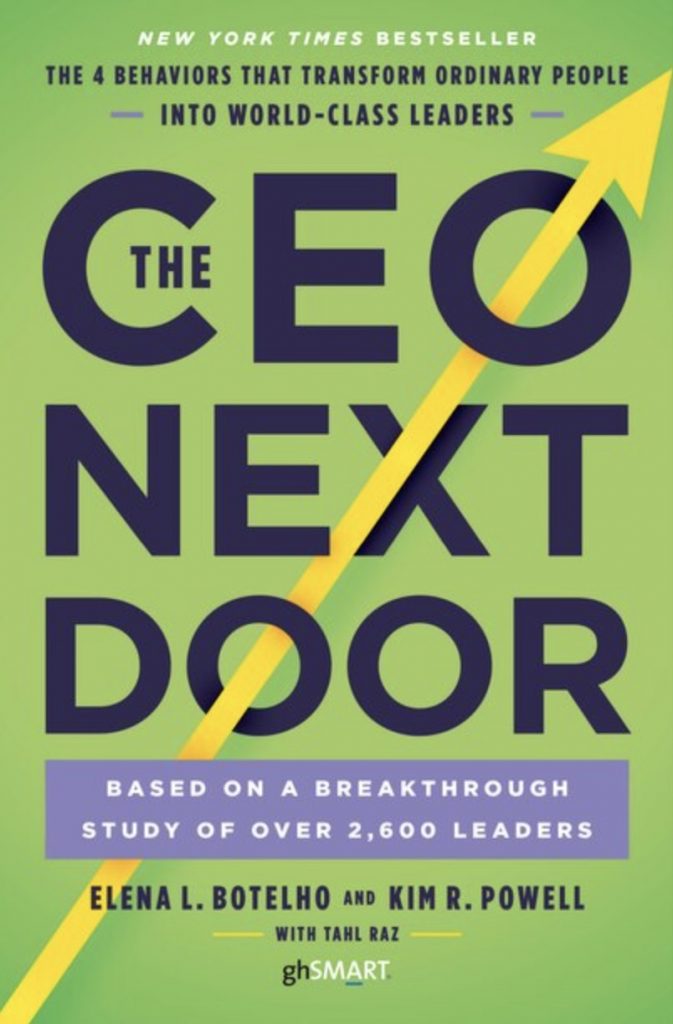Key Quote:
“Great CEOs empower all their employees to raise their voices and, equally important, they make sure they stay close enough to the field to listen” (p. 76).— Elena Botelho and Kim Powell
Key Points and Concepts
The CEO Genome Behaviors
Researchers used a ghSMART data set of 17,000 leadership assessments and a subset of 2,600 leader assessments, which were extracted and analyzed in greater depth. The results found:
• You do not need to go to an Ivy League school to become a CEO. Only 7% of the CEOs analyzed graduated from an Ivy League college and 8% did not even complete college (p. 10).
• CEOs did not believe they were destined for greatness from an early age. Over 70% of the CEOs interviewed did not set out to become CEOs early in life. Only after fifteen-plus years of experience did they start to consider the possibility of thriving in a CEO role (p. 10).
• Not all CEOs are egotistical. CEOs who defined themselves as “independent” were twice as likely to underperform and the weakest CEO candidates used “I” at a much higher rate than “we” (p. 10).
• Not all successful CEOs have an extroverted personality. Over a third of CEOs described themselves as “introverted” (p. 11).
Four Behaviors That Transform Ordinary People into World-Class Leaders
1. Decide: Speed Over Precision
Make Decisions Faster: “Successful CEOs stood out for decisiveness itself – the ability to make decisions with speed and conviction. Decisive CEOs in the study were twelve times more likely to be high performers” (p. 22). Additionally, the study uncovered that 94% of executives who rated poorly on the decisive competency decided too slowly, not too quickly.
Make the Complex Simple: Using a framework adds speed to decision making by simplifying the complex. It also lets the entire organization know what is important so everyone can make better decisions.
• Example: Doug Peterson, the former CEO of McGraw Hill Financial, “noticed that the successful CEOs were willing to make decisions with only eighty percent of the information. They didn’t need to wait around. It wasn’t intuitive; they weren’t gambling. It was about quick judgment based on listening to lots of viewpoints very quickly” (p. 25).
Give a Voice, not a Vote: It would be a mistake to make a decision by yourself because there is a huge web of people who inform and affect every move the CEO makes. By actively involving others in the decision process, the multiple inputs improve the quality of the decision and help executives build ownership and create buy-in with stakeholders.
Make Fewer Decisions: CEOs should step back from the majority of decision making and allow employees to make the vast majority of decisions.
• Example: Madeline Bell, CEO of the Children’s Hospital of Philadelphia (CHOP), was confronted with the decision to choose between gel or foam soap. She looked down the chain of command, instead of up. She believed that people closest to the daily operations should be the ones to debate and decide (p. 28-30).
Get Better Every Time by Looking Back: Successful CEOs build a system to learn from decisions. By using Daniel Kahneman’s practice from his book Thinking, Fast and Slow, one should determine if the rational and deliberative or the quick and often unconscious decisions need improvements to then strengthen those decision-making muscles.
Look Inward to Condition Decisiveness: Leaders often do not realize the degree to which their physical or emotional state affects their ability to make decisions.
• Example: David Coleman, president of the College Board, led the organization through a redesign of the SAT. He believes that getting enough rest was key in terms of his ability to be decisive (p. 36).
Look to the Future: Some leaders think forward to the future and reason back to the type of decisions needed to get to that spot.
• Example: When Ashley Wheater became the artistic director of The Joffrey Ballet in Chicago, the organization was in a precarious state – both in funding and quality of work – with audiences dwindling. He made a contrarian decision to stand for inclusion and elevating it through art. He used a forward-looking view by reminding himself of the “10/10/10 technique.” He imagined how he would feel about a decision in 10 minutes, 10 months, and 10 years, which Chip and Dan Heath wrote in their book Decisive: How to Make Better Choices in Life and Work (p. 36-37).
Seek Contrarian Perspectives: CEOs realize that not all input is equal. “Smart decision makers get help to counter their own bias while carefully screening their sources” (p. 38). When the executive is too close to the issue, the 3D-ing process is recommended. As a group, the information and case are presented and Discussed. A champion leads the Debate. And, once a committee has heard from both sides, it Decides (p. 39).
2. Engage for Impact: Orchestrate Stakeholders to Drive Results
Lead with Intent: CEOs are dependent on the actions of others – their interdependence is key.
Because CEOs are dependent on others, being independent is not ideal. “Two out of every three highly independent CEOs are likely to underperform expectations” (p. 41).
Common principles of CEOs include that they lead with intent, understand their players, and build routines to support their intent.
CEOs use skilled persuasion to clarify what they want others to think, feel, and do.
Understand the Players: CEOs engage for impact by understanding who their stakeholders are and what they want.
• Example: Neil Fiske, former CEO at Bath & Body Works, drove progress through his ability to hear what others – consumers, bosses, and employees – were saying and how to put it together in
a vision. Neil became a detective by paying careful attention to the words and gestures to understand what truly mattered.
Break Down the Sound Barrier: CEOs must take steps so people feel comfortable opening up and sharing critical information (p. 59).
• Example: Robert Hanson, former CEO of American Eagle and The John Hardy Company, would show respect, learn the needs of employees and customers, and meet at a common ground to eliminate a power play.
3. Relentless Reliability: Deliver Consistently
In the study, reliability scored the lowest with leaders. This is important because “CEOs who are known for being reliable are fifteen times more likely to be high performing, and their odds of getting hired are double those of everyone else” (p. 63).
Make Mistakes Safe: Leaders destigmatize mistakes. At CHOP, they changed the language from “near misses” to “good catches” (p. 75).
Level the Playing Field: “Great CEOs empower all their employees to raise their voices and, equally important, they make sure they stay close enough to the field to listen” (p. 76).
Create a Precise Shared Vocabulary: Specific shared vocabulary helps build a stronger culture because “language is one of the ways a culture signals what is important” (p. 78).
• Build the Machinery of Consistent Process: “Of the strong CEO candidates studied, 75% scored high on organization and planning skills” (p. 78). Learning to build processes for consistency is helpful because consistency becomes momentum.
4. Adapt Boldly: Ride the Discomfort of the Unknown
Actively Seek Out Novelty: Learning a new skill will help you grow.
• Example: Nancy Phillip, former CEO of ViaWest, described that “her best training to be CEO didn’t take place while she was wearing a suit. She spent three years traveling the world, including a month in China during which she never met another Westerner. Discomfort was the only constant, and every new experience required an improvised response” (p. 89).
Acquire the Skills They Don’t Have: “Adaptable leaders work to acquire the skills they don’t have; they get in the ring and practice them,
no matter how awkward or uncomfortable they feel at first” (p. 91).
Let Go of Approaches that Have Worked Before: “Great leaders are constantly becoming better, different, more informed. In this act of constant learning, they are becoming more comfortable with discomfort” (p. 93).
Build Diverse Information Networks: Actively curious CEOs assume everything is relevant by expanding the definition of who their competitors are.
Use the Power of Questions: CEOs tend to ask the best questions and ask for responses to be facts.
• Example: Tom Bell, former CEO of the Cousins REIT, learned that lease rates in real dollars were trending downwards. He became curious about the prices in other markets. Ultimately, it led the company to sell over a billion dollars in office assets at the height of the market in 2006 (p. 96-97).
• Tackle “Premortems” Before Postmortems: During periods of growth, CEOs should continue to explore what could cause them to fail and create a signal list for each issue.
• Look into the Crystal Ball of Customer Experience: The top CEOs immerse themselves into the customer experience and spend time in the customer process.
Botelho, Elena L., et al. (2018). The CEO Next Door: The 4 Behaviors That Transform Ordinary People Into World-Class Leaders. New York, Currency.

“People are attached to the status quo. To ease endowment, catalysts surface the costs of inaction and help people realize that doing nothing isn’t as costless as it seems.”
“When someone hears a recommendation, they try to make sense of it. To sort out what the recommendation means. Does it say something about the thing being recommended, or does it just say something about the recommender themselves?” This is why offering multiple testimonies is so important.
“Catalyzing change isn’t just about making people more comfortable with new things; it’s about helping them let go of old ones.”
